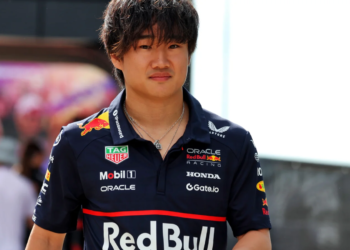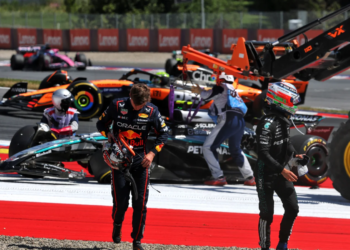Several Formula 1 drivers have called for alterations to Turn 6 at Melbourne’s Albert Park circuit following the recent incident between Fernando Alonso and George Russell.
Alonso was handed a 20-second time drop for his driving tactics that caught Russell unaware, resulting in the Mercedes driver going off-road and crashing into the barriers.
Russell’s crash came at the same corner where Alex Albon wrote off his Williams FW46 chassis in opening practice.
Albon crashed in the same corner in last year’s Australian GP, while Dennis Hauger also sustained an incident in the 2024 Formula 2 Feature Race.
“We’ve seen quite a few accidents where cars have kind of been bounced back onto the track, which is something that we’ve spoken about, and I think it should be addressed,” said McLaren’s Oscar Piastri.
“Maybe just the angle of the wall or potentially even the speed of the corner. It’s obviously quite a quick corner now.
“So, it is something that we have spoken about with the FIA. And we’ll see what comes. But yeah, there’s probably been now a few too many crashes with cars ending up in the middle of the track to not do something about it.”

Russell’s Mercedes was left stranded on its side in the middle of the circuit after his crash before a Virtual Safety Car neutralised the race, but he confessed that Turn 6 at Albert Park is “probably one of the best corners on that circuit.
“So I wouldn’t want to see that corner change”.
“I think everything is correct. Just the position of that wall, even if it’s closer to the track but in line with the circuit, at least you wouldn’t bounce off into the racing line.”
Albon, Turn 6’s other F1 victim of the Australian GP weekend added that the kerbs at Turn 6 also contribute to the dangers of that particular corner.
“As we have these low cars now, everything we touch, we can use the first bit of kerb, but if you go too far across and you hit the second kind of ramp section, it forces the car into the air,” he said.
Daniel Ricciardo, like Russell, was full of praise for Turn 6 and hopes that if any changes come about, it isn’t to the profile of the turn, but just the way the wall interacts with the cars.
“I love that corner,” the Australian said.
“It’s a really, really fun corner. In qualifying it’s downshift to sixth and pretty much get back to full throttle. So, it’s a ballsy corner.
“The only thing I don’t like about it is, as we’ve seen, if you crash, you come back onto the track.
“I don’t like that scenario, but from a pure driving experience, it’s an amazing corner. So, I don’t want that changed. But the safety of it is bad.
“Unfortunately, that is the sort of corner that is very vulnerable for a big incident, so if they have to change it and that’s the only way to get the safety from it then, OK yes, they should.
“But if they can make it safer but still keep the speed and everything of it then that’s my vote.”
Changes could be on the horizon, as Motorsport.com understands that discussions are already being had to reprofile the turn, introduce a tarmac run-off and make alterations to the wall on exit.
This will come as welcome news to Australian GP race winner Carlos Sainz, who said “That corner needs to be reviewed, which is already something I said in the last driver’s briefing.
“I just don’t like the last few incidents that we’ve seen in this corner, also in other categories. It just doesn’t give me a very good feeling.
“It’s a great corner, don’t get me wrong. I love driving in a qualifying lap. It’s just when it comes to racing, there’s been just too many examples of a car coming back onto a track and being very narrow there.”
Following adjustments ahead of the 2022 Australian GP which opened up Turn 6 to improve speeds and encourage overtaking on the following straight, just two years on, it looks as if changes could come again to reign things in.










The basics are still down to not having consistent safety design standards for ALL tracks, whether permanent or temporary.
Here again, as pointed out its not the track plan but the run-off and barriers.
There are no excuses here that the barriers are know to be directly in ‘line of fire’ and bouncing cars back onto the track.
Predictable and confirmed by experience.
Not that FIA gets it right elsewhere.
Remember Grosjean embedded on fire, car broken in two, in a failed armco barrier. Supposedly a barrier that would never get hit by a crashing car.
Yet another of the 20 or so a year formally investigated by FIA accidents for which since since 2014 investigation summary, let alone full, reports have been published.
No wonder the FIA can’t prevent or mitigate accidents if 200 reports are not published. Instead we have to wait for rumours or intelligent media to report for example why cars now have intrusion bulkheads as well as impact structures,
Or as with Grosjean, why a impenetrable barrier didn’t work as designed??